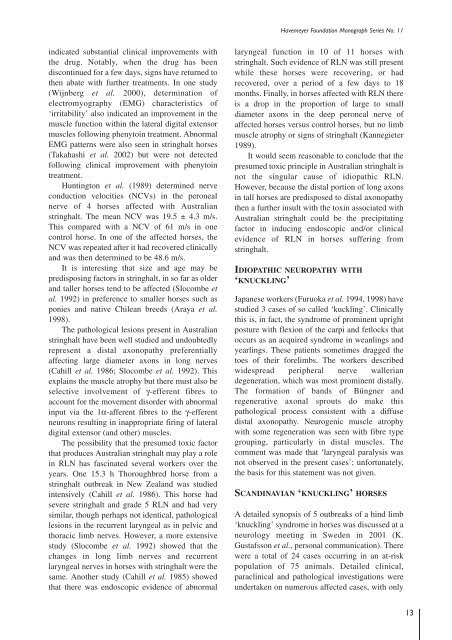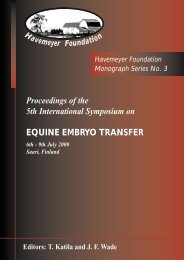Proceedings of a Workshop on - The Havemeyer Foundation
Proceedings of a Workshop on - The Havemeyer Foundation
Proceedings of a Workshop on - The Havemeyer Foundation
Create successful ePaper yourself
Turn your PDF publications into a flip-book with our unique Google optimized e-Paper software.
<strong>Havemeyer</strong> Foundati<strong>on</strong> M<strong>on</strong>ograph Series No. 11<br />
indicated substantial clinical improvements with<br />
the drug. Notably, when the drug has been<br />
disc<strong>on</strong>tinued for a few days, signs have returned to<br />
then abate with further treatments. In <strong>on</strong>e study<br />
(Wijnberg et al. 2000), determinati<strong>on</strong> <str<strong>on</strong>g>of</str<strong>on</strong>g><br />
electromyography (EMG) characteristics <str<strong>on</strong>g>of</str<strong>on</strong>g><br />
‘irritability’ also indicated an improvement in the<br />
muscle functi<strong>on</strong> within the lateral digital extensor<br />
muscles following phenytoin treatment. Abnormal<br />
EMG patterns were also seen in stringhalt horses<br />
(Takahashi et al. 2002) but were not detected<br />
following clinical improvement with phenytoin<br />
treatment.<br />
Huntingt<strong>on</strong> et al. (1989) determined nerve<br />
c<strong>on</strong>ducti<strong>on</strong> velocities (NCVs) in the per<strong>on</strong>eal<br />
nerve <str<strong>on</strong>g>of</str<strong>on</strong>g> 4 horses affected with Australian<br />
stringhalt. <strong>The</strong> mean NCV was 19.5 ± 4.3 m/s.<br />
This compared with a NCV <str<strong>on</strong>g>of</str<strong>on</strong>g> 61 m/s in <strong>on</strong>e<br />
c<strong>on</strong>trol horse. In <strong>on</strong>e <str<strong>on</strong>g>of</str<strong>on</strong>g> the affected horses, the<br />
NCV was repeated after it had recovered clinically<br />
and was then determined to be 48.6 m/s.<br />
It is interesting that size and age may be<br />
predisposing factors in stringhalt, in so far as older<br />
and taller horses tend to be affected (Slocombe et<br />
al. 1992) in preference to smaller horses such as<br />
p<strong>on</strong>ies and native Chilean breeds (Araya et al.<br />
1998).<br />
<strong>The</strong> pathological lesi<strong>on</strong>s present in Australian<br />
stringhalt have been well studied and undoubtedly<br />
represent a distal ax<strong>on</strong>opathy preferentially<br />
affecting large diameter ax<strong>on</strong>s in l<strong>on</strong>g nerves<br />
(Cahill et al. 1986; Slocombe et al. 1992). This<br />
explains the muscle atrophy but there must also be<br />
selective involvement <str<strong>on</strong>g>of</str<strong>on</strong>g> γ-efferent fibres to<br />
account for the movement disorder with abnormal<br />
input via the 1α-afferent fibres to the γ-efferent<br />
neur<strong>on</strong>s resulting in inappropriate firing <str<strong>on</strong>g>of</str<strong>on</strong>g> lateral<br />
digital extensor (and other) muscles.<br />
<strong>The</strong> possibility that the presumed toxic factor<br />
that produces Australian stringhalt may play a role<br />
in RLN has fascinated several workers over the<br />
years. One 15.3 h Thoroughbred horse from a<br />
stringhalt outbreak in New Zealand was studied<br />
intensively (Cahill et al. 1986). This horse had<br />
severe stringhalt and grade 5 RLN and had very<br />
similar, though perhaps not identical, pathological<br />
lesi<strong>on</strong>s in the recurrent laryngeal as in pelvic and<br />
thoracic limb nerves. However, a more extensive<br />
study (Slocombe et al. 1992) showed that the<br />
changes in l<strong>on</strong>g limb nerves and recurrent<br />
laryngeal nerves in horses with stringhalt were the<br />
same. Another study (Cahill et al. 1985) showed<br />
that there was endoscopic evidence <str<strong>on</strong>g>of</str<strong>on</strong>g> abnormal<br />
laryngeal functi<strong>on</strong> in 10 <str<strong>on</strong>g>of</str<strong>on</strong>g> 11 horses with<br />
stringhalt. Such evidence <str<strong>on</strong>g>of</str<strong>on</strong>g> RLN was still present<br />
while these horses were recovering, or had<br />
recovered, over a period <str<strong>on</strong>g>of</str<strong>on</strong>g> a few days to 18<br />
m<strong>on</strong>ths. Finally, in horses affected with RLN there<br />
is a drop in the proporti<strong>on</strong> <str<strong>on</strong>g>of</str<strong>on</strong>g> large to small<br />
diameter ax<strong>on</strong>s in the deep per<strong>on</strong>eal nerve <str<strong>on</strong>g>of</str<strong>on</strong>g><br />
affected horses versus c<strong>on</strong>trol horses, but no limb<br />
muscle atrophy or signs <str<strong>on</strong>g>of</str<strong>on</strong>g> stringhalt (Kannegieter<br />
1989).<br />
It would seem reas<strong>on</strong>able to c<strong>on</strong>clude that the<br />
presumed toxic principle in Australian stringhalt is<br />
not the singular cause <str<strong>on</strong>g>of</str<strong>on</strong>g> idiopathic RLN.<br />
However, because the distal porti<strong>on</strong> <str<strong>on</strong>g>of</str<strong>on</strong>g> l<strong>on</strong>g ax<strong>on</strong>s<br />
in tall horses are predisposed to distal ax<strong>on</strong>opathy<br />
then a further insult with the toxin associated with<br />
Australian stringhalt could be the precipitating<br />
factor in inducing endoscopic and/or clinical<br />
evidence <str<strong>on</strong>g>of</str<strong>on</strong>g> RLN in horses suffering from<br />
stringhalt.<br />
IDIOPATHIC NEUROPATHY WITH<br />
‘KNUCKLING’<br />
Japanese workers (Furuoka et al. 1994, 1998) have<br />
studied 3 cases <str<strong>on</strong>g>of</str<strong>on</strong>g> so called ‘kuckling’. Clinically<br />
this is, in fact, the syndrome <str<strong>on</strong>g>of</str<strong>on</strong>g> prominent upright<br />
posture with flexi<strong>on</strong> <str<strong>on</strong>g>of</str<strong>on</strong>g> the carpi and fetlocks that<br />
occurs as an acquired syndrome in weanlings and<br />
yearlings. <strong>The</strong>se patients sometimes dragged the<br />
toes <str<strong>on</strong>g>of</str<strong>on</strong>g> their forelimbs. <strong>The</strong> workers described<br />
widespread peripheral nerve wallerian<br />
degenerati<strong>on</strong>, which was most prominent distally.<br />
<strong>The</strong> formati<strong>on</strong> <str<strong>on</strong>g>of</str<strong>on</strong>g> bands <str<strong>on</strong>g>of</str<strong>on</strong>g> Büngner and<br />
regenerative ax<strong>on</strong>al sprouts do make this<br />
pathological process c<strong>on</strong>sistent with a diffuse<br />
distal ax<strong>on</strong>opathy. Neurogenic muscle atrophy<br />
with some regenerati<strong>on</strong> was seen with fibre type<br />
grouping, particularly in distal muscles. <strong>The</strong><br />
comment was made that ‘laryngeal paralysis was<br />
not observed in the present cases’; unfortunately,<br />
the basis for this statement was not given.<br />
SCANDINAVIAN ‘KNUCKLING’ HORSES<br />
A detailed synopsis <str<strong>on</strong>g>of</str<strong>on</strong>g> 5 outbreaks <str<strong>on</strong>g>of</str<strong>on</strong>g> a hind limb<br />
‘knuckling’ syndrome in horses was discussed at a<br />
neurology meeting in Sweden in 2001 (K.<br />
Gustafss<strong>on</strong> et al., pers<strong>on</strong>al communicati<strong>on</strong>). <strong>The</strong>re<br />
were a total <str<strong>on</strong>g>of</str<strong>on</strong>g> 24 cases occurring in an at-risk<br />
populati<strong>on</strong> <str<strong>on</strong>g>of</str<strong>on</strong>g> 75 animals. Detailed clinical,<br />
paraclinical and pathological investigati<strong>on</strong>s were<br />
undertaken <strong>on</strong> numerous affected cases, with <strong>on</strong>ly<br />
13








